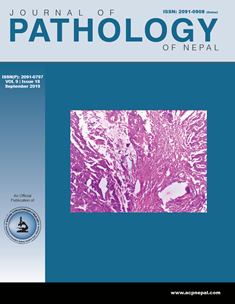Approach to native medical renal biopsy interpretation of glomerular disease
DOI:
https://doi.org/10.3126/jpn.v9i2.25664Keywords:
Electron microscopy, Glomerulonephritis, Immunohistology, Renal biopsyAbstract
Diverse pathogenetic mechanisms and clinical manifestation of renal diseases may produce the same renal morphologic pattern or variety of renal morphologic pattern can lead to the same clinical syndrome. The primary role of the renal biopsy is to provide a diagnosis and information about disease activity and chronicity. The systematic approach to native medical renal biopsy includes evaluation of the four compartments of the kidney sequentially (glomeruli, tubules, interstitium, and blood vessels). The diagnosis in renal pathology is an integrated process in which we must analyze all clinical data, light microscopy, immunohistology, and electron microscopy studies for diagnosis. The aim of the article is to describe the handling of the renal tissue in the anatomical pathology laboratory. It also provides the guideline to renal biopsy evaluation and approach to arrive at the diagnosis of glomerular diseases with similar clinical presentations.
Downloads
Downloads
Published
How to Cite
Issue
Section
License
This license enables reusers to distribute, remix, adapt, and build upon the material in any medium or format, so long as attribution is given to the creator. The license allows for commercial use.




